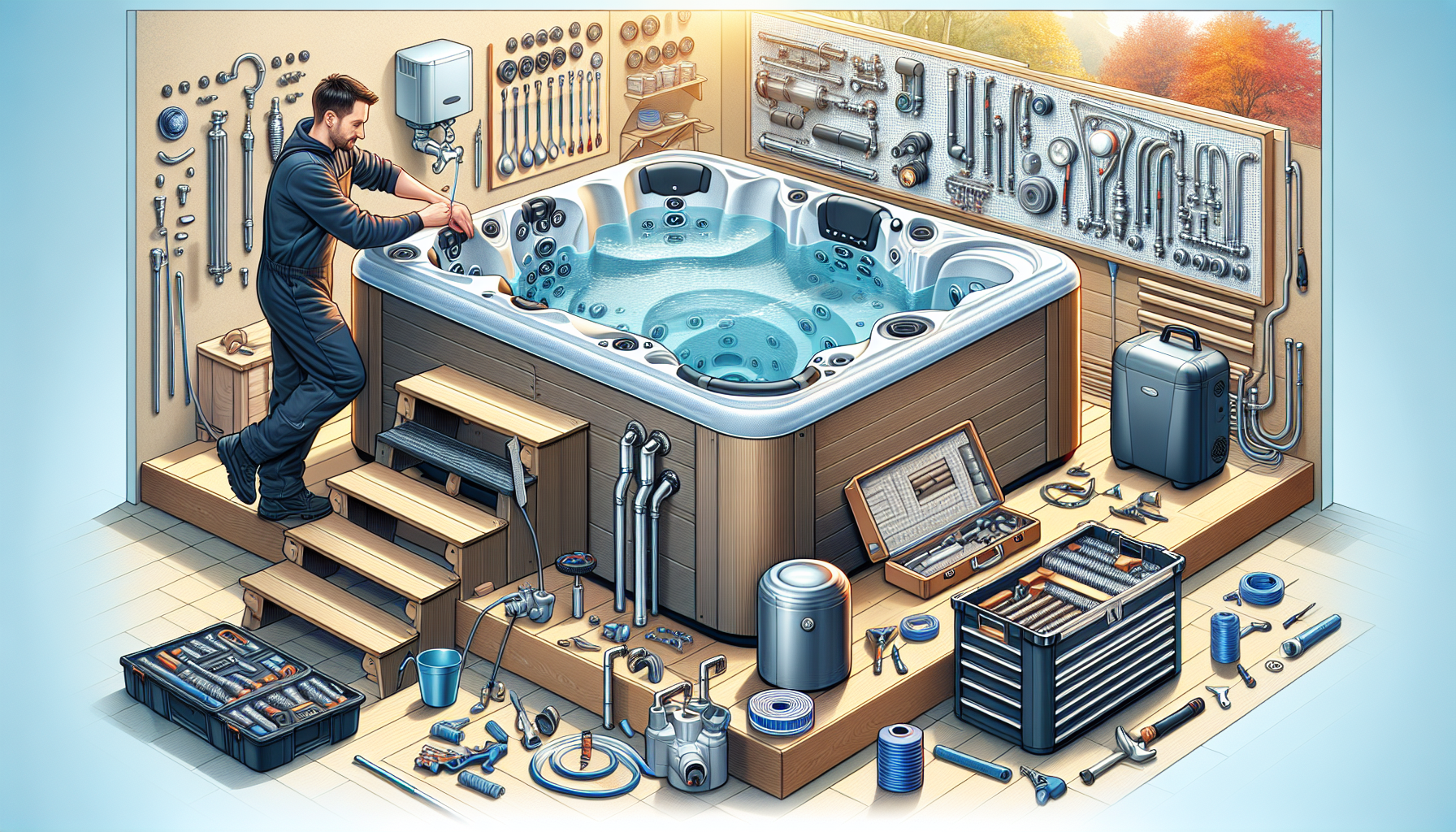Setting Up Your Hot Tub: The Fun Starts Here!
Before taking that plunge into bubbly bliss, there’s some planning to tackle. Don’t worry—I’ve got your back. This guide will show you the ropes on the essentials, minus the fluff.
Let’s Talk Local Rules
Before buying that hot tub, you’ll need to do a bit of detective work on local rules. Think building permits, local codes, and those pesky HOA regulations. These rules can vary depending on where you live, so it’s always smart to check with your local authorities first and avoid any nasty surprises during the installation.
Here’s a quick checklist to start with:
- Permits: Do you need a building permit? Better to know now than get fined later.
- Building Codes: Some places want fences or gates around your hot tub. Keeps the kids safe, which means more peace of mind for you.
- Zoning Restrictions: Figure out where you can and can’t place that hot tub.
- HOA Rules: If you’ve got a homeowners’ association, they might have some rules too. Better check!
| Local Rules | What You Need to Know |
|---|---|
| Permits | Usually needed |
| Building Codes | Fences and gates may be required |
| Zoning | Placement restrictions |
| HOA | Community-specific rules |
For more nitty-gritty details, pop over to our hot tub installation checklist.
Power It Up!
Getting the right electrical setup is a big deal. Each hot tub model can have different needs, so let’s break it down:
- Dedicated Circuit: Most tubs need their own electrical circuit—think 220-240V. Yep, it’s that important.
- GFCI Protection: This is all about safety. You need a Ground Fault Circuit Interrupter (GFCI) to stop electric shocks. A licensed electrician is a must here.
- Electrical Panel: Make sure your home’s panel can handle the load. Sometimes, an upgrade is necessary.
- Professional Installation: Don’t play with fire—get a licensed electrician to do your setup. Safety, people, safety.
| Electrical Stuff | What To Do |
|---|---|
| Dedicated Circuit | 220-240V, don’t skimp! |
| GFCI Protection | No-brainer |
| Electrical Panel | Might need an upgrade |
| Pro Help | Always recommended |
These steps help you avoid the chaos and keep everything smooth. If you need specifics for your HotSpring or FreeFlow tub, head to our detailed hot tub electrical requirements.
Wrapping It Up
Following this guide saves you headaches and sets you up for some seriously relaxing hot tub time. Ready to go deeper? Check out our section on preparing for hot tub installation. Load up on all the info you need and make that first dip unforgettable!
Getting Ready for Your Hot Tub
Getting a hot tub is exciting, but making sure it’s set up right is key. This means having a solid spot for it and making sure water drains away correctly.
Building a Strong Base
A strong base is super important for your hot tub. If you don’t get the weight right, your hot tub could be in trouble. A hot tub for three can weigh up to 4,000 pounds when filled with water and people. Your base should support at least 125 pounds per square foot.
| Part | Weight Capacity Needed |
|---|---|
| Hot Tub (3-person) | 4,000 lbs |
| Foundation Load Capacity | 125 lbs/sq. ft. |
Using Concrete
Concrete is the best option; it’s both strong and affordable. A thick 6-inch concrete pad with gravel underneath for drainage works great. This setup can handle freezing weather without moving around (Hydropool Hot Tubs).
You also need a flat surface to avoid warping. Dips can stress the tub’s shell, causing cracks.
Managing Water Drainage
To keep your hot tub and its base safe, good drainage is crucial. The ground should drain water easily and stay flat. If the surface slopes slightly, it shouldn’t be more than ½” over 8 feet.
Drainage Tips:
- Groundwater Control: Make sure water doesn’t pool under the hot tub, which could shift it in freezing weather.
- Surface Slope: A tiny slope can help with runoff, but keep it level for stability.
Want more info? Check out our article on getting your hot tub space ready.
Paying attention to your base and drainage means your hot tub will last longer and stay in great shape. For more tips, look at our beginner’s guide to hot tub installation or pro tips on hot tub installation.
How to Set Up Your Hot Tub
Wiring and Power
Getting your hot tub wired up isn’t rocket science, but it does need the right touch. You’re either looking at a 120V or 220V connection, and trust me, each one’s got its own quirks (This Old House). Most of the backyard varieties use a 240-volt hook-up with a 50-amp service; think of it as the hot tub version of a high-octane engine. You’ll need a special GFCI breaker and a dedicated line running from your home’s panel box to the hot tub.
| Type | Voltage | Amperage | Setup |
|---|---|---|---|
| Standard | 120V | 15-20A | Regular outlet |
| High Power | 220V | 50A | GFCI breaker, wired connection |
You have to follow the National Electric Code to keep everything safe and working right. For the nitty-gritty details, check out our hot tub electrical setup guide. And hey, there’s no shame in calling a pro electrician—better safe than sorry!
Weight Issues
Ever seen a three-person hot tub? Loaded up with water and folks, it can tip the scales at a whopping 4,000 lbs (This Old House). That’s a whole lotta weight, and you don’t want it sinking into the ground or, worse, crashing through your deck.
| Tub Size | Filled Weight (lbs) | Min Load Capacity (lbs/sq ft) |
|---|---|---|
| 2-3 people | 3,000 – 4,000 | 125+ |
| 4-6 people | 4,000 – 6,000 | 125+ |
| 6+ people | 6,000+ | 150+ |
So, make sure your surface can handle at least 125 lbs per square foot. Ever heard of a structural engineer? They’re the folks who can tell you if your foundation is solid enough to hold the load. Skipping this step might lead to some nasty surprises—think cracks, shifts, or your hot tub suddenly becoming an underground pool.
For more “don’t-make-my-mistakes” advice, take a look at our hot tub installation mistakes to avoid. And if you’re gearing up, our preparing for hot tub installation section is your best friend.
Keep Your Hot Tub Happy: Maintenance and Longevity
Taking good care of your hot tub will keep it safe, clean, and bubbling perfectly for years. Let’s chat about the importance of balanced chemicals and regular cleaning to make your hot tub last.
Don’t Mess with the Chemicals
Keeping your hot tub’s chemical levels balanced is a must. It’s the secret sauce to clear, safe water. Regular water tests and tweaking keep everything on point.
Here’s Your Chemical Cheat Sheet:
| Chemical | Ideal Level (ppm) |
|---|---|
| Chlorine | 1.0 – 3.0 |
| Bromine | 3.0 – 5.0 |
| pH | 7.2 – 7.8 |
| Alkalinity | 80 – 120 |
- Chlorine and Bromine: These warriors kill bacteria and sanitize the water.
- pH Levels: Keeps water from being too harsh or too basic, preventing skin burns and equipment wear.
- Alkalinity: Helps keep the pH in check and prevents crazy swings.
A weekly maintenance checklist will be your best buddy to keep in line. This includes testing the water with a strip, adjusting levels, and giving the water a shock treatment to keep it crystal clear.
For more nitty-gritty on chemicals, dive into our hot tub installation guide.
Get Down with Cleaning
Regular cleaning keeps your hot tub looking fresh and running smoothly. Here’s a simple playbook to follow:
Cleaning Playbook:
- Daily:
- Check the water temperature.
- Scoop out debris—that rogue leaf or any other unwelcome guest.
- Weekly:
- Test and adjust chemicals.
- Clean the filters for smooth water flow.
- Wipe the cover to thwart mold and algae (National Pools and Spas).
- Monthly:
- Wipe down the shell and cover with a sponge and vinegar mix to zap build-up and stains (National Pools and Spas).
- Inspect and clean the jets for a soothing soak.
Got more questions? Check out our DIY hot tub installation tips or peek at our guide. A solid cleaning schedule will keep your tub in top shape, ensuring prime relaxation for years.

